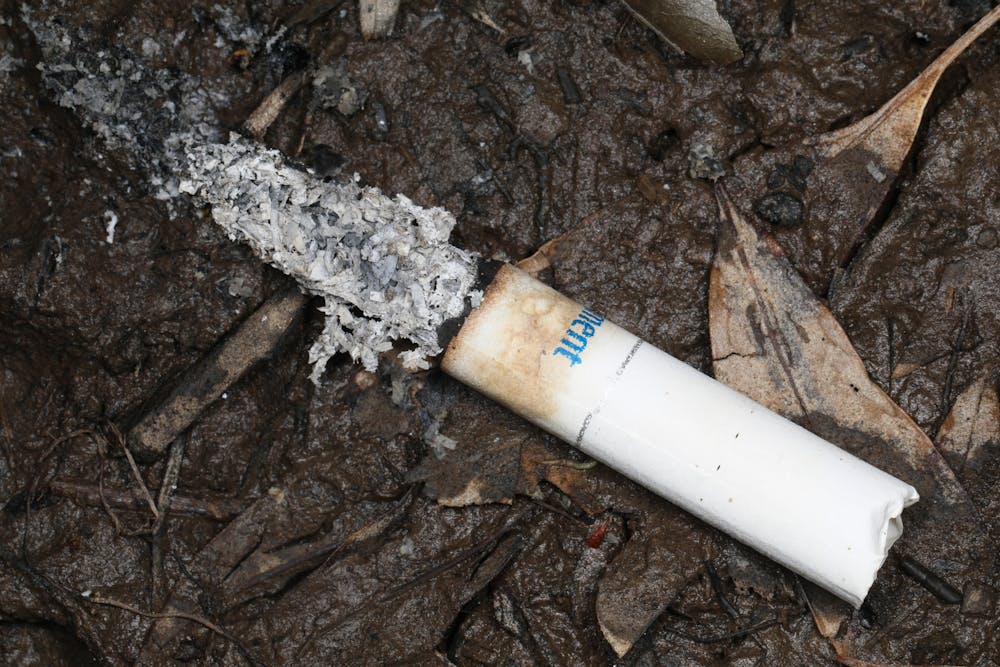On Monday, Sept. 16, the Institute for Global Tobacco Control at the Bloomberg School of Public Health hosted Thomas E. Novotny, professor emeritus of epidemiology and biostatistics at the San Diego State University School of Public Health. In a talk titled “Paddling Upstream to Prevent Tobacco Pollution,” Novotny discussed the type of waste produced from tobacco as well as to regulatory actions that may prevent the continuation of mass pollution from tobacco products.
Novotny opened the talk by defining the term Tobacco Product Waste (TPW) to include traditionally understood waste products from smoking like traditional cigarette butts, but also newer forms of nicotine products like e-cigarettes and nicotine pouches. He stated that cigarette butts are the most littered item found on beaches and waterways. In 2021, cigarette butts consisted of 12% of total debris items picked up.
One central detriment of tobacco pollution originates from the use of cigarette filters. Originally created to prevent tobacco pieces from entering the smoker’s mouth, cigarette filters now capture some of the toxic chemicals of the cigarette and are now advertised to reduce the potential risks of smoking. These filters are produced from cellulose acetate, a non-biodegradable plastic. When these filters are littered, both the plastic of the filter and the chemicals captured harm the environment.
“While this is not a petroleum-based plastic, this is a bioplastic. But, it’s [still] plastic, and it doesn’t biodegrade readily. It can degrade when you step on it, or disperse with ideal UV and time, but it doesn’t really go away,“ Novotny stated. “The filters accumulate particulates as well as chemicals that can leach out into the environment, whether the filter acts as a teabag leaching out or as a carrier with all the microplastics that have the chemicals that adhere to them.”
Novotny estimated that up to 4.5 trillion butts per year are discarded into the environment, with around 95% of commercial cigarettes containing the cellulose acetate filter. One cigarette filter consists of 12-15,000 individual plastic strands, with 100 microfibers being released daily. Up to 0.3 million tons of microplastics from cigarette filters may enter oceans annually.
The San Francisco Estuary Institute conducted an urban water runoff study based on sewers in the San Francisco Bay Area region and concluded that cellulose acetate was a predominant plastic present. Additionally, chemicals from cigarettes and their filters can impact organisms in the environment, including fish, worms and mussels.
Cigarettes contain carcinogenic tobacco-specific nitrosamines and can have multiple harmful implications for humans, such as estrogenicity, the ability for a compound to bind to an estrogen receptor and teratogenesis, which occurs when an organism is impacted by developmental defects between conception and birth. Regarding the topic of TPW’s impact on human health, Novotny highlighted its uncertainty and the importance of human interactions with the environment.
“While we don’t really know if TPW is doing anything to us, we do know that these chemicals come out. The leaching is evident, and we can measure it. The pathways have potential through food chains and water contamination. The biologic plausibility — which is one of the key pieces of assessing causality — is there,” he said.
Novotny addressed the significant misconception smokers have regarding cigarette filters. According to a national survey of American smokers and non-smokers, 33.2% of smokers, 24.3% of non-smokers and 21.3% of non-smokers incorrectly believed that filters reduced the harmful effects of smoking. 55.3% and 40% of all participants believed that the filters were made of cotton and paper, respectively, with 28.9% knowing that cigarette filters had a plastic component.
“The general population, policy-makers, and smokers – most people don’t realize that the cigarette filter is made up of plastic,“ he stated. “Most people think that the filters have some benefit. Even Philip Morris (an American tobacco company) found that their customers thought that cigarette butts were okay to be tossed into the environment. There’s a big knowledge gap to correct here and will have to change in order to make any policy work.”
The lecture ended with the current efforts to prevent and decrease the amount of TPW produced. One major global endeavor is the UN Treaty to End Plastic Pollution, initially introduced in 2022 by the United Nations Environment Programme, with cigarette filters named a single-use form of plastic. The World Health Organization (WHO) recommended banning the sale of filtered cigarettes and is attempting to bring more attention to the issue through potential editing of Article 18 of the WHO Framework Convention on Tobacco Control, which covers tobacco and its impact on the environment.
“I think this whole idea of plastics is what people will pay attention to. We will just keep calling it a plastic, a single-use plastic, like a plastic bag. People will accept this fact and will get rid of it. That’s the upstream solution rather than just informing people about it,” Novotny emphasized.





